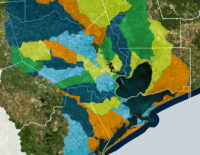COMMENT OF THE DAY: WATER BORDER PROS AND CONS  “Abolishing arbitrarily-bounded entities with taxing powers like the HCFCD and instead creating entities that are specific to individual watersheds seems like it might make some sense. I do worry that certain areas, especially less affluent ones, would suffer from poor or corrupt leadership; and you can’t simply merge watersheds as the T.E.A. would merge school districts. However, that’d certainly be more democratic and accountable. That’s a trade-off which might be worth making.” [TheNiche, commenting on Group Petitions for 13-County Flood Planning] Watershed boundaries superimposed across Houston-area county boundaries: Galveston Bay Foundation and Houston Area Research Council’s Find Your Watershed map
“Abolishing arbitrarily-bounded entities with taxing powers like the HCFCD and instead creating entities that are specific to individual watersheds seems like it might make some sense. I do worry that certain areas, especially less affluent ones, would suffer from poor or corrupt leadership; and you can’t simply merge watersheds as the T.E.A. would merge school districts. However, that’d certainly be more democratic and accountable. That’s a trade-off which might be worth making.” [TheNiche, commenting on Group Petitions for 13-County Flood Planning] Watershed boundaries superimposed across Houston-area county boundaries: Galveston Bay Foundation and Houston Area Research Council’s Find Your Watershed map





The downside described by niche are downsides we already have. The current gang of idiots are simply unable to rise to the occasion and do the job.
I wouldn’t describe the HCFCD as a “gang of idiots” at all. They have limited resources and cannot simply will into existence new funding mechanisms. They also have a duty to their constituents to use those resources in such a way as to achieve the biggest bang for the buck, but a lot of those projects are concentrated in a few watersheds and by its nature that means that there are a lot of constituents that receive disproportionate benefits. It’s understandable that constituents will be frustrated, but it’s damned-if-you-do, damned-if-you-don’t.
.
I was thinking on this some more and I think that legislative reforms would be most successful if regional flood control entities were created to replace more local entities (perhaps taking in watersheds falling more or less within various ‘Councils of Government’, such as H-GAC). Taxation and capital expenditures could occur strictly on a watershed-by-watershed basis, but the regional entity would coordinate and administer all of those activities and would be large enough to achieve some economies of scale as well as press scrutiny and public notoriety. Certain projects might be designated as regional priorities, and draw from a regional tax; for example protections of the TMC (which is largely tax-exempt and yet crucial to the regional economy and regional disaster relief) or the Ike Dike (which affects numerous watersheds) might be good candidates.